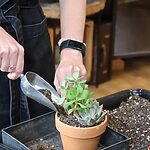Table of Content
- About
- Light
- Humidity
- Water
- Soil
- Pest & Diseases
- Feed
- Pruning & Propagating
- Repotting
- Troubleshooting & Tips
- Toxicity
- Species
- Strobilanthes dyeriana
About
The Perisian Shield could easily be one of the most mesmerising plants you could wish for as a houseplant owner. There is not much else quite like it, set apart by the incredible iridescent colours of its leaves. The wide and long shield-shaped dark green foliage is embroidered with fantastically bright metallic purple that fills the gaps between the veins of the leaf. This is truly a plant to be admired.
Persian Shield, also known as the royal purple plant, is formally known as Strobilanthes dyeriana, this species of tropical flowering plant is an acanthus and belongs to the family Acanthaceae. Naturally, this evergreen shrub is only found in a small part of Asia, located in the tropical forests of Myanmar.
Persian Shield performs best in these types of warm climates but due to its popularity, it’s grown not only as a houseplant but also as an outdoor plant bringing striking colours to garden borders across the world. In warmer climates, this plant can survive as an evergreen but is often only grown as an annual in cooler regions or as a perennial in regions where the winters are not so harsh.
This love for warmth is what has made this plant best-suited as a houseplant, being able to provide a more stable and consistent environment has led this plant to flourish with relative ease for most houseplant keepers. The only problem is they do tend to have a bit of a shelf life, after around three years, as the plant starts to mature, it will lose the iridescent clouring on its leaves. While it will still make for a handsome plant with dark green foliage it is just not quite as impressive as the vivid and vibrant purple that once filled its leaves. Harshly, at this point, the Parisian Sheild will often be thrown out or only serves as a plant to propagate from.
Light
Without a doubt the plant will require the brightest spot you have, it will also need some direct sunlight in order to keep its shiny iridescent leaves looking at their best. It will be best suited in a position where it can receive an hour or so of the early morning sun and then spend the rest of its day in bright indirect light.
Be careful not to expose the plant to excessive sunlight, this won’t damage the leaves but it will cause the colour to fade and look a bit washed.
These plants often look at their best in slightly shaded areas as the lack of light really allows the deep colours to show, however too little light will also cause the colours to fade and create leggy growth as it stretches towards the nearest light source.
Humidity
Perisian Sheilds are used to a humid tropical forest, so as houseplants they will appreciate high levels of humidity. They will be most comfortable if you can keep them in an environment of around 55 to 65% humidity but with regular misting or improving the humidity directly around the plant, they can still happily survive in the average household humidity of 40%.
Pro Tip
The best way to maintain high humidity is to use a humidifier placed about a meter away from your plant to provide high ambient humidity. Alternatively, you could place your plant on an undertray filled with coya pebbles or small stones that are sitting in a shallow layer of water. Make sure the plant is not submerged in any water as this can lead to root rot. As the water from the undertray evaporates from the surface of the pebbles or stones it will keep humidity levels high exactly where you need it most.
Water
Perisian Sheild is a thirsty plant and during the warmer months, it will need to be checked multiple times a week. The amount of light the plant is receiving will determine how much water it needs, the higher the light level the quicker it will dry out and the more often it will need to be watered.
But being a tropical native, Persian Shield can bounce back quickly. It will tend to dramatically wilt if you are a little late with the watering but once it has had a drink it will soon return to its former glory without much fuss.
Top Tip
Always water from the base of the plant. Sitting your plant in an under tray and allowing it to absorb water from the base will reduce the risk of overwatering and is a good preventative measure for fungus gnats. Remember to always set a timer from the minute the plant goes in the water, we don’t want any forgotten casualties on our hands.
Pro Tip
Before you water your plant, take note of the weight of the pot. Once you’ve watered the plant, try to notice the difference in weight from before. Now you can quickly tell if your plant needs water by just lifting it up.
Soil
Persian Shield prefers well-drained soil that can retain moisture between watering. The ideal soil mix for them will be nutrient-rich, allow for good aeration, be slightly acidic, and free-draining with a smidge of water retention
Most houseplant potting mixes will be sufficient, but you can always add perlite for some additional drainage, and vermiculite for added water retention. With a combination of these, you can provide the best environment for your plant to thrive.
Pest & Dieases
It is good practice to regularly check your plants for any signs of aphids, red spider mites, mealy bugs, and thrips. You may notice some signs of distress and allow yourself time to prevent a full-blown attack.
The most common pests that are attracted to Persian Shield are aphids and mainly occur during periods of water stress.

Check our video on homemade pest remedies or head over and read are Fungus Gnat Fact Check
Feed
These plants can be quick growers and will need regular feeding to keep them happy. Like most houseplants, to promote healthy roots stems, and leaves they will need a steady supply of nitrogen, phosphorus, and potassium. The most important is nitrogen this will help to keep the leaves looking at their best.
A good liquid houseplant feed can be applied at half strength every four weeks during the growing season. There’s no need to feed during the winter, light levels are much lower and the plant won’t use as much energy to grow.
Top Tip
A drop of houseplant feed in a mister bottle is a great way to feed via its foliage. This will help to promote those glossy green leaves!
Pruning & Propagating
Not much pruning is required with these plants but to make them look bushy and abundant you can pinch out the new growth during the warmer months, this will help to develop more stems and leaves allowing the plant to become much denser.
REMEMBER – Always use clean and sharp pruning scissors!
Cuttings – The easiest and the best way to propagate are to use stem cuttings. Take a cutting of around 2 to 3 inches from the healthiest-Repo stem. Remove any leaves from the bottom of the cutting, ensuring to leave at least one at the top.
Place your cutting straight into a jar with fresh sphagnum moss. This is probably the easiest way to propagate as it has the least steps involved. Simply take your cutting, find a jar or pot preferably with no drainage holes, fill it up with fresh moss and nestle your cutting in the centre.
Fill up the jar with water so the moss has been evenly watered and then drain out all excess water making sure not to leave any at the bottom of the jar.
Now just keep an eye on your new cutting checking the moss every couple of days to ensure it hasn’t dried out. This same process can be used by placing your stem cutting straight into the soil.
Repotting
Persian Sheild can grow pretty big if you allow them, while this sounds great it often makes care for the plant that much more difficult. So when it comes to repotting, which should be around every couple of years, it is best to give the plant a good root trim as this will help to control the overall size of the plant and stop it from getting out of hand.
After a few years, the colour of the leaves will naturally fade as it reaches maturity. The best thing to do at this stage is to take as much cutting material as possible and discard the mother plant.
The pot size can increase by one step up every year for as long as you have the space to house the new influx of growth. If you have reached your maximum pot size you will need to top-dress the plant once a year with a fresh layer of soil to replenish the nutrients.
The best time to repot your plant is when spring arrives. Outside temperatures will rise and the daylight hours will increase. When this happens your plant will react quickly to the environmental change and start producing lots of new roots and foliage growth.
You will need to pick a pot with good drainage, we don’t want water hanging around the roots. Next, fill a third of the way up with a Houseplant Potting mix(insert link). Place the root ball of the plant in the centre of the pot.
Next, fill the pot with the rest of your potting mix and firm down the soil.
When you’ve finished and got your plant back in the perfect spot you can give it a thorough watering to settle the plant into its new pot. Keep a close eye on it for the first few weeks and then relax back into your normal watering and feeding schedule.
Troubleshooting & Tips
- Pinch out the tops of new growth during the spring and summer to keep the plant compact and bushy
- In conditions where light levels are too low, the plant will become leggy as it stretches towards the light.
- This plant can bounce back quickly even after intense wilting.
- Remove the flowers as they start to form on the plant this will help to save energy and increase the vigour of the plant.
Toxicity
It is safe to keep these wonderful plants in your home as they are non-toxic to both humans and animals.
Species

Strobilanthes dyeriana
Strobilanthes dyeriana have long lance-shaped leaves, with a slightly serrated edge. They are velvety in a stunning shade of iridescent purple that shimmers with metallic hues of silver and pink in the light. The plant grows in a bushy manner, with a dense and compact growth habit that adds a sense of fullness.
If you enjoyed this guide head over to Articles & Blogs to learn more or check out our YouTube for even more useful information!











